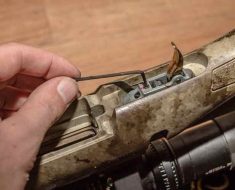“Master the kick, control the shot.”
Reducing Revolver Recoil: Tips and Tricks
Revolvers are a popular choice for many gun enthusiasts due to their reliability and simplicity. However, one downside to using a revolver is the recoil that comes with firing it. Recoil can be uncomfortable and even painful for some shooters, but there are techniques and upgrades that can help reduce the recoil and make shooting a revolver a more enjoyable experience.
One of the most effective ways to manage recoil when shooting a revolver is to use proper grip and stance. A firm grip on the revolver will help absorb some of the recoil and prevent the gun from jumping in your hand. Make sure to grip the revolver high on the backstrap and keep your wrists locked to help control the recoil. Additionally, using a two-handed grip will provide more stability and control over the gun, further reducing the felt recoil.
Another technique to help manage recoil is to practice proper breathing and trigger control. By taking slow, steady breaths and squeezing the trigger smoothly, you can minimize the jerking motion that can exacerbate recoil. Focus on maintaining a consistent grip and trigger pull throughout each shot to help reduce the impact of recoil on your shooting experience.
In addition to proper technique, there are also upgrades available that can help reduce recoil when shooting a revolver. One popular upgrade is the installation of a recoil-reducing grip. These grips are designed to absorb and dissipate some of the energy from the recoil, making shooting more comfortable and controllable. There are a variety of recoil-reducing grips available on the market, so be sure to choose one that fits your revolver and shooting style.
Another upgrade that can help reduce recoil is the addition of a muzzle brake or compensator. These devices attach to the end of the revolver’s barrel and redirect some of the gases produced when firing, helping to counteract the upward force of recoil. Muzzle brakes and compensators can be especially effective for shooters who are sensitive to recoil or who shoot high-powered rounds.
When it comes to managing recoil when shooting a revolver, it’s important to remember that everyone’s experience will be different. What works for one shooter may not work for another, so it’s important to experiment with different techniques and upgrades to find what works best for you. Remember to always prioritize safety when shooting and consult with a professional if you have any questions or concerns about managing recoil with your revolver.
In conclusion, recoil management is an important aspect of shooting a revolver that can greatly impact your shooting experience. By using proper grip and stance, practicing good breathing and trigger control, and considering upgrades like recoil-reducing grips and muzzle brakes, you can help reduce the impact of recoil and make shooting a revolver more enjoyable. Experiment with different techniques and upgrades to find what works best for you, and always prioritize safety when shooting. With practice and the right equipment, you can effectively manage recoil and become a more confident and accurate shooter with your revolver.
Best Upgrades for Revolver Recoil Management
Revolvers are a popular choice for many gun enthusiasts due to their reliability and simplicity. However, one common issue that revolver owners face is managing recoil. Recoil can be a significant factor in accuracy and comfort when shooting, so it’s important to find ways to mitigate its effects.
There are several techniques that can help improve recoil management when shooting a revolver. One of the most important things to remember is to have a firm grip on the gun. This will help absorb some of the recoil and prevent the gun from jumping around in your hand. Make sure to position your dominant hand high on the grip and wrap your fingers around it tightly. Your non-dominant hand should support the gun from underneath, providing additional stability.
Another technique to improve recoil management is to focus on your stance. A proper shooting stance can help absorb some of the recoil and keep you steady while shooting. Stand with your feet shoulder-width apart and slightly bend your knees. Lean slightly forward at the waist and keep your upper body relaxed. This will help you absorb the recoil and maintain control of the gun.
In addition to these techniques, there are also several upgrades that can help improve recoil management on a revolver. One popular upgrade is a recoil-reducing grip. These grips are designed to absorb some of the recoil when shooting, making it more comfortable and easier to control the gun. There are many different types of recoil-reducing grips available, so it’s important to find one that fits your hand comfortably and provides the right amount of cushioning.
Another upgrade that can help improve recoil management is a muzzle brake or compensator. These devices attach to the end of the barrel and redirect some of the gases produced when firing, helping to reduce recoil and muzzle rise. Muzzle brakes and compensators come in a variety of styles and designs, so it’s important to do some research to find the best option for your revolver.
Finally, upgrading to a heavier revolver can also help improve recoil management. Heavier guns tend to absorb more recoil than lighter ones, making them easier to control when shooting. If you’re struggling with recoil on your current revolver, consider upgrading to a heavier model to see if it makes a difference.
In conclusion, managing recoil on a revolver is an important aspect of shooting accurately and comfortably. By using proper techniques and considering upgrades like recoil-reducing grips, muzzle brakes, and heavier guns, you can improve your recoil management and enjoy shooting your revolver even more. Experiment with different techniques and upgrades to find what works best for you and make shooting your revolver a more enjoyable experience.
Mastering Recoil Control with Your Revolver
Revolvers are a popular choice for many gun enthusiasts due to their reliability and simplicity. However, one aspect of shooting a revolver that can be challenging for some is managing the recoil. Recoil is the backward movement of the gun that occurs when a round is fired. Properly managing recoil is essential for accuracy and control when shooting a revolver.
There are several techniques that can help you master recoil control with your revolver. One of the most important techniques is to have a firm grip on the gun. Gripping the revolver tightly with both hands will help absorb some of the recoil and prevent the gun from jumping in your hand. Make sure your dominant hand is high on the grip and your support hand is wrapped around it to provide additional support.
Another technique to help manage recoil is to use proper stance and body positioning. Stand with your feet shoulder-width apart and slightly staggered, with your dominant foot back. Lean slightly forward at the waist and keep your arms extended but not locked. This stance will help absorb some of the recoil and allow you to maintain control of the gun.
Breathing control is also important when it comes to managing recoil. Take a deep breath, exhale halfway, and then hold your breath as you squeeze the trigger. This will help stabilize your body and reduce any movement that could affect your shot placement. Remember to continue breathing normally after firing the shot.
In addition to these techniques, there are also upgrades you can make to your revolver to help improve recoil management. One popular upgrade is installing a muzzle brake or compensator. These devices attach to the end of the barrel and redirect gases to help reduce muzzle rise and felt recoil. This can make shooting your revolver more comfortable and improve your accuracy.
Another upgrade to consider is installing a recoil-reducing grip. These grips are designed to absorb some of the recoil and provide a more comfortable shooting experience. They come in a variety of materials and styles, so you can choose one that fits your hand size and shooting preferences.
Finally, consider upgrading your ammunition to help reduce recoil. Lighter loads or lower-caliber rounds will produce less recoil than heavier loads or higher-caliber rounds. Experiment with different types of ammunition to find what works best for you and your shooting style.
In conclusion, mastering recoil control with your revolver is essential for accuracy and control when shooting. By using proper techniques such as grip, stance, and breathing control, you can improve your recoil management skills. Additionally, consider upgrading your revolver with devices such as muzzle brakes, recoil-reducing grips, and lighter ammunition to further enhance your shooting experience. With practice and the right equipment, you can become a more confident and accurate shooter with your revolver.
Top Techniques for Managing Recoil on Revolvers
Revolvers are a popular choice for many gun enthusiasts due to their reliability and simplicity. However, one common issue that revolver shooters face is managing recoil. Recoil can affect accuracy and control, making it important to learn techniques and consider upgrades to help mitigate its effects.
One of the most effective techniques for managing recoil on a revolver is to focus on your grip. A proper grip can help distribute the recoil force more evenly, reducing muzzle flip and allowing for faster follow-up shots. To achieve a solid grip, make sure to wrap your dominant hand around the grip firmly, with your fingers positioned high on the backstrap. Your non-dominant hand should then support the gun from underneath, creating a strong two-handed grip.
Another important aspect of recoil management is stance. A proper shooting stance can help absorb some of the recoil energy, making it easier to control the gun. To achieve a stable stance, stand with your feet shoulder-width apart and slightly staggered. Bend your knees slightly and lean forward into the gun, keeping your upper body relaxed but firm. This will help you absorb the recoil and maintain control over the revolver.
In addition to technique, there are also upgrades that can help improve recoil management on a revolver. One popular upgrade is the installation of a muzzle brake or compensator. These devices attach to the end of the barrel and redirect gases to help reduce muzzle rise and felt recoil. While muzzle brakes are more common on semi-automatic pistols, there are options available for revolvers as well.
Another upgrade to consider is a recoil-reducing grip. These grips are designed to absorb some of the recoil energy, making it easier to control the gun during rapid fire. There are many different styles and materials available, so it’s important to find one that fits your hand comfortably and provides the level of recoil reduction you desire.
Finally, consider upgrading your ammunition. Lighter loads or lower-recoil cartridges can help reduce the felt recoil of a revolver. While this may sacrifice some stopping power, it can make shooting more comfortable and allow for faster follow-up shots. Experiment with different loads to find the right balance between recoil management and effectiveness.
In conclusion, managing recoil on a revolver is essential for accuracy and control. By focusing on grip, stance, and upgrades, you can improve your shooting performance and enjoy your revolver to its fullest potential. Practice these techniques regularly and don’t be afraid to try new upgrades to find what works best for you. With dedication and the right tools, you can become a master of recoil management on your revolver.
Improving Accuracy by Managing Revolver Recoil
Revolvers are a popular choice for many shooters due to their reliability and simplicity. However, one of the drawbacks of using a revolver is the recoil that comes with each shot. Recoil can affect accuracy and make shooting less enjoyable. Fortunately, there are techniques and upgrades that can help manage revolver recoil and improve accuracy.
One of the most effective ways to manage revolver recoil is to practice proper grip and stance. A firm grip on the revolver will help absorb some of the recoil and prevent the gun from jumping in your hand. Make sure to grip the revolver high on the backstrap and keep your wrists locked to reduce muzzle flip. Additionally, a proper shooting stance, such as the Weaver or Isosceles stance, can help distribute recoil energy more evenly and improve control over the revolver.
Another technique to manage revolver recoil is to use a two-handed grip. By using both hands to hold the revolver, you can better control the recoil and maintain accuracy. Make sure to position your support hand under the shooting hand and apply equal pressure with both hands to minimize muzzle rise. Practice dry firing with a two-handed grip to build muscle memory and improve your shooting technique.
In addition to proper grip and stance, there are also upgrades that can help reduce revolver recoil. One popular upgrade is the installation of a recoil-reducing grip. These grips are designed to absorb and dissipate recoil energy, making shooting more comfortable and improving accuracy. There are a variety of recoil-reducing grips available on the market, so be sure to choose one that fits your revolver and shooting style.
Another upgrade that can help manage revolver recoil is the installation of a muzzle brake or compensator. These devices attach to the end of the revolver barrel and redirect gases to reduce muzzle rise and felt recoil. Muzzle brakes and compensators can be especially beneficial for shooters using powerful magnum cartridges that produce significant recoil. However, be aware that adding a muzzle brake or compensator may increase noise and muzzle blast, so be sure to use proper hearing protection when shooting.
In conclusion, managing revolver recoil is essential for improving accuracy and enjoying shooting. By practicing proper grip and stance, using a two-handed grip, and considering upgrades such as recoil-reducing grips and muzzle brakes, you can effectively reduce recoil and enhance your shooting experience. Remember to always prioritize safety and follow proper shooting techniques when handling a revolver. With practice and the right equipment, you can become a more accurate and confident shooter with your revolver.





